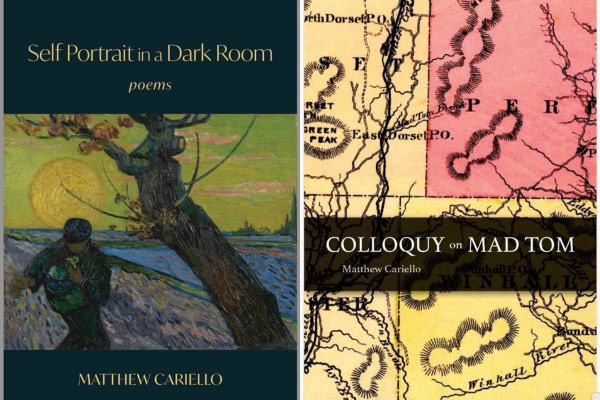Research Spotlight: Matthew Cariello

Periodically the Communications Team reaches out to members of the Department of English faculty and graduate program and asks them to elaborate on a current research or creative project they are working on or have recently completed. For this spotlight, we talked with Senior Lecturer Mathew Cariello about his two new poetry collections: Self Portrait in the Dark (Finishing Line Press, August 15) & Colloquy on Mad Tom (Bordighera Press, May 13).
How would you describe these two collections? How do the poems work?
Self Portrait in the Dark explores how individual moments of awareness can be connected to create a life story. These poems have an ekphrastic impulse — many of them are based on paintings and drawings by Vincent van Gogh — but a better reading of them would be as improvisations on themes: presence, absence, pain, love, and how we “spill our light” in the world. The speaker is various. Sometimes the poet, sometimes the painter — and sometimes a mixture of the two. And although the book tells a story, “Getting / it right wasn't the point.” The reader is invited to be a participant, not merely a spectator in the recreation of the larger narrative.
Colloquy on Mad Tom is a contemplation on loss, grief, and persistence. The poems move back and forth in time, from childhood to old age, innocence to experience, constantly revisiting the pivot points upon which lives turn. The poem “Crow,” which begins “There is no province but the liminal,” provides a kind of passkey to the book: all things in constant flux, shaping and reshaping themselves until “A chance crow stitches the patchwork shut,” which completes the picture, at least temporarily. Many of the poems take the form of a modern sonnet written in couplets. At the heart of the book is a colloquy spoken by two people — but not to each other.
How did you become interested in this creative project?
These are lifelong projects. Self Portrait has its roots in formative childhood memories of a Van Gogh print on the wall in my parents’ apartment: “the way the wheat field / spilled from the tree / sinewy & oceanic / the angle of descent / inevitable every / thing / in terrible / motion / I was 3.” I’ve been talking with Van Gogh my whole life.
Colloquy represents the inevitable progression of grief over my younger sister’s death 40 years ago, as my family and I collectively “wonder why the day won’t pass.” The only answer is that “it never stopped starting, was always ending.” One thing we can do with grief is “Imagine bees and blossoming wood smoke – / bees circling woodsmoke circling bees.”
Are there any supporters of this project that you would like to acknowledge?
I only want to gratefully acknowledge the constant support of my family.
What's next for you?
My next poetry collection is a series of broken sonnets with the working title “Misreading Keats.” The approach is based on the principle of the palimpsest, the ancient method of writing new material over old, for instance on vellum or wax: “The original writing was scraped and washed off, the surface resmoothed, and the new literary material written on the salvaged material.” The process was expedient, a way of recycling precious raw materials in a pre-industrial world.
Similar to how modern technology allows us to find traces of the original writing on old documents, the poems in this book rewrite but don’t erase the original artifacts on which they’re based. Each of these poems uses much of the subject matter, language, cadence, and tone of the original artifacts referred to in the subtitle and rewrites or reimagines them without erasing the original.
Additionally, I have two novels completed, which are circulating among editors and agents.
